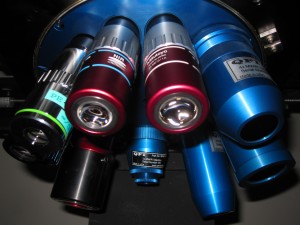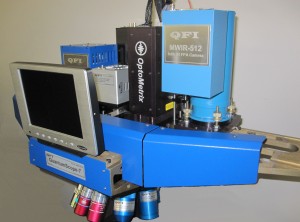QuantumScopeTM Failure Analysis Microscope Systems:
QuantumScopeTM microscopes are designed to accept multiple sensors, covering a broad range of analytical techniques for failure analysis requirements. A single QuantumScopeTM configured with a multiple sensor microscope head can locate open lines, ohmic shorts, impedance issues, leakage currents, leaky capacitors, timing errors, oxide defects, resistive vias, latchup, ESD damage, and dynamic failures.

Direct Sensor-to-Lens Coupling Allows NIR, Visible, and MWIR Lenses on Same Turret for Maximum Flexibility and FA Throughput
Core system design concepts center on minimizing sample set-up time and maximizing data collection efficiency. The user sets up the device under test (DUT) once. Then, various analytical techniques, sensors, optics, and software are engaged on the centric QuantumScopeTM system. No time is lost to move the DUT to another instrument; biasing stability and test conditions are preserved because the DUT stays in place. A QuantumScopeTM can be configured as any combination of the failure analysis microscopy solutions listed below. Single function microscopes are available with upgrade paths to additional techniques. Specifications and analytical capabilities of the individual microscopy solutions are the same as options in a multi-sensor system or as standalone systems.
Please select the links immediately below to see details of the individual failure analysis microscopy solutions:
- emmiTM Photoemission Microscopy
- XIVATM LSIM Laser Signal Injection Microscopy
- Thermal-HS MWIR Hot Spot Detection Microscopy

Unique Slide Sensor Stage Embraces Multiple Sensors and Techniques on a Single Microscope Optical Head - Maximizing Defect Capture Rates
Sensors are mounted on a movable (slide-based) stage, and objective lenses (up to 12) are mounted on a turret. This design minimizes the optical path to simply the selected micro-objective and camera (or other sensor), which avoids extending relays, beam splitters and folds in the optical path. The unique optical design eliminates unnecessary optical interfaces and dramatically reduces introduction of optical aberrations from reflection, deflection, scattering, and absorption. Optical quality and reliability are preserved. QFI’s optical purist approach offers a distinct data collection and signal preservation advantage over more complex (but less efficient) optical paths relying on relays, splitters, and folds.
Different laboratory environments and applications drive customers to seek different mechanical platforms for optical path support and DUT interface. QFI has designed a family of standard mechanical platforms, which answer the majority of application requirements. If customer requirements diverge from standard solutions, QFI will design custom mechanical platforms and analytical solutions for such unique requirements. Please select link immediately below to visit the mechanical platforms page:
You are welcome to request additional information via the information request link:
